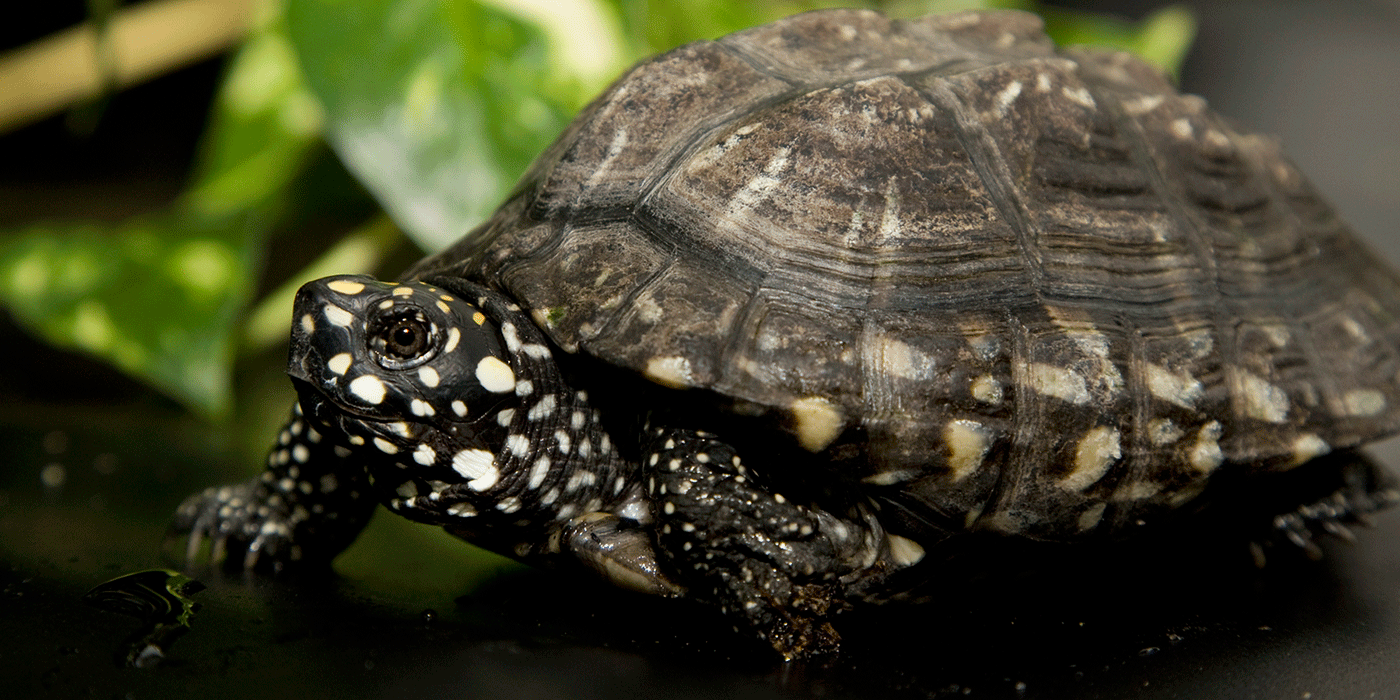Physical Description
Spotted pond turtles are named for the yellow or white spots on their black heads, legs and tails. They have large heads and short snouts, and their webbed feet help them swim. The pond turtle's carapace, or upper shell, is generally black with bright patterns that fade with age. Males have concave carapaces and larger, thicker tails than females.
Pond turtles bask in the sun to regulate their body temperature. At times, they will gather and rest on vegetation (either on water or on land). In the summer, in areas where their usual water source dries up, spotted pond turtles undergo a short migration to move into wells in the river bed. They are able to dig quite deep to reach these sites.
Size
They can grow up to about 40.5 centimeters (16 inches).
Native Habitat
Spotted pond turtles are found in the northern region of the Indian subcontinent in the Indus and Ganges river drainages. Their range includes parts of Pakistan, northern India, Bangladesh, and Nepal. They are semi-aquatic and can typically be found in shallow, standing waters, such as oxbow lakes, ponds and marshes.
They prefer water with thick vegetation that provides cover, as well as places to lie and bask. In the summer, pond turtles remain mostly submerged in the water. They may be seen poking their heads out of the water for long periods of time. During the winter, they rest under bushes, dry vegetation, water reeds and dry leaves.
Lifespan
Spotted pond turtles typically live 15-20 years in zoos.
Communication
When they retreat into their shells, spotted pond turtles make a soft croak.
Food/Eating Habits
Spotted pond turtles are primarily carnivorous and eat aquatic invertebrates. They use the bony surfaces of their strong jaws to crush the shells of snails, prawns, crabs and other crustaceans. They also eat mollusks, fish, amphibians and cereal grains, and will sometimes graze on grasses.
Sleep Habits
Spotted pond turtles are crepuscular, meaning they are most active at twilight (dusk and dawn).
Reproduction and Development
Spotted pond turtles reach sexual maturity between 6 and 8 years old. Females dig a bowl-shaped nest for their eggs that is about 6-10 centimeters (2-4 inches) deep. The nest is dug into loamy soil (soil with sand, silt and clay) in a spot where it will be concealed by bushes and other vegetation.
Females generally lay two clutches of eggs per year, the first in December or January and the second just before or after the monsoon season in February or March. This timing varies a bit depending on geography; in northern India, the eggs are laid in April and May. Each clutch usually contains about 20-30 eggs, but the largest clutch on record had 36 eggs. The second clutch of the year tends to be slightly smaller than the first. The eggs incubate for about 50-60 days before hatching.
Conservation Efforts
The spotted pond turtle is considered endangered in Bangladesh and vulnerable in India. Spotted pond turtles are also listed on CITES Appendix I. Several sanctuaries in northern India protect pond turtles, and this species is reported to be relatively abundant in India's protected areas.
Harvesting is the largest threat to these turtles. They are often exported to food markets throughout Asia, and eaten locally in India. They are sold as pets in local markets, as well as in the U.S. and Europe. Spotted turtle populations are also negatively affected by habitat loss. The vegetation that these turtles live in is often removed when lands are converted for agriculture.
Help this Species
Be a smart consumer! Avoid animal-skin products, even those marked “faux,” to ensure you’re not contributing to the illegal hunting of this species.
Practice ecotourism by being an advocate for the environment when you’re on vacation. During your travels, support, visit or volunteer with organizations that protect wildlife. Shop smart too! Avoid buying products made from animals, which could support poaching and the illegal wildlife trade.
Choose your pets wisely, and do your research before bringing an animal home. Exotic animals don’t always make great pets. Many require special care and live for a long time. Tropical reptiles and small mammals are often traded internationally and may be victims of the illegal pet trade. Never release animals that have been kept as pets into the wild.
Share the story of this animal with others. Simply raising awareness about this species can contribute to its overall protection.
Meet the Animals
Two spotted pond turtles live at Reptile Discovery Center.
Smithsonian's National Zoo and Conservation Biology Institute. (n.d.). Spotted pond turtle. Retrieved November 30, 2025, from https://nationalzoo.si.edu/animals/spotted-pond-turtle
Animal News

Giant Panda Qing Bao Gets a Checkup ›

7 Spooktacular Animal Facts for Halloween ›

